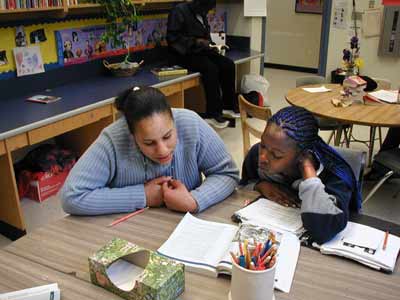Creating a refuge for Berkeley High’s ‘fragile’ girls
Relationships are fundamental to female learning, says graduate-student researcher
![]()
| 26 February 2003
| |  Special-education students at Berkeley High have found a haven in Elizabeth Anderson’s classroom, which is set up to promote peer interaction and language use among girls who have been diagnosed with learning disabilities. Carol Hyman photo |
When Elizabeth Anderson arrived at Berkeley High School a year ago, she planned to develop the reading component of the school’s special-education program. What the Berkeley Ph.D. candidate in Education ended up creating, instead, was what one school administrator calls a classroom “safe haven” for some the school’s most “fragile” girls.
In Room G104h, up to 10 girls at a time join Anderson — during and after school — to read, sew, write, explore friendships, or deal with life crises.
“Elizabeth has created an atmosphere in which our girls can connect with each other on an intellectual and emotional level,” says Clare Davies, head of the high school’s special-education program. “The classroom is always open throughout the day.”
Most of Anderson’s students have been diagnosed with language-based learning disabilities. Yet ironically, she says, they’ve ended up in classes that have limited, rather than facilitated, language use and language development. Research shows that strong relationships are fundamental to female learning. But “because girls are such a small minority in special education,” she says, “they had few opportunities for positive peer interactions.”
Thanks to Anderson’s guidance, and their own hard work, the girls in Room G104h have achieved successes they’d never dreamed of.
Liana, 18, a senior, never expected to graduate from high school. This semester, she and four of her classmates are taking an evening class in child-development at Merritt College, in Oakland — with Anderson in the back of the room taking classroom notes for a group study session.
“I like working with kids, and by getting some college credits in child care, I’ll be able to get a real job,” says Liana. “It makes me feel really good, and my mom is proud of me, too.”
Fourteen-year old Socorro, a junior whose first language is Spanish, received much of her subject-matter instruction in English before she had the English-language skills to absorb the information. Consequently, says Anderson, “she has enormous gaps in content area knowledge. This is what holds her back — not a disability.”
After 20 years as a special-education teacher, Anderson decided to pursue a Ph.D. so that she could explore and address her concerns about special education “in a larger sphere” than one classroom. Her work with the students at Berkeley High will serve as a basis for her dissertation, which looks at how girls in special education are referred and labeled, and the consequences of that process.
“Elizabeth came upon a need that was terrific, but there were no resources of models for her,” notes Anderson’s faculty adviser, Berkeley Professor of Education Lilly Wong Fillmore. In that vacuum, she has had to create her own models — which help to account for the girls’ progress. “They have become a peer support group for each other,” Fillmore notes.
Anderson, for her part, is “constantly amazed” at her students’ strength — “the way they keep coming back to a school system that rejects them so soundly. I am hoping they have become kids who value what other people may denigrate in them — such as their bilingualism, creativity, and assertiveness.”

